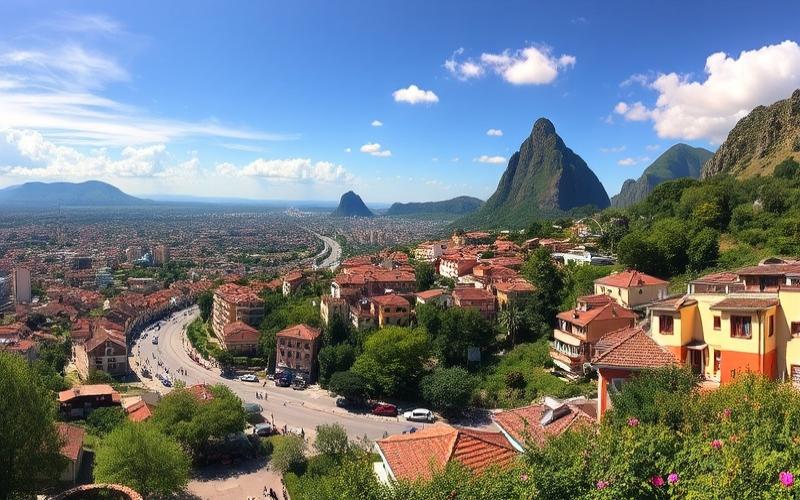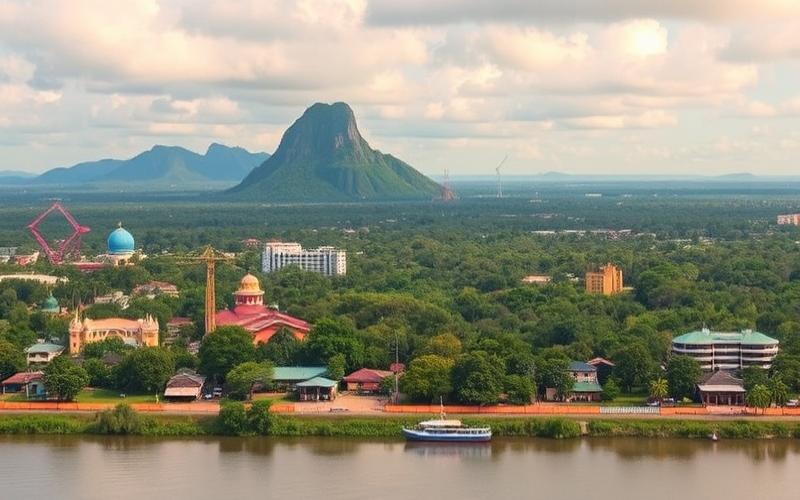
 Published on and written by Cyril Jarnias
Published on and written by Cyril Jarnias
Facing rapid population growth and an aging Brazilian population, the senior service residence market is experiencing rapid expansion in Brazil. With a growing number of retirees seeking living solutions adapted to their specific needs and improved living standards, these residences offer an environment that combines independence and assistance.
Domestic and international investors are increasingly interested in this expanding sector, seeking to capitalize on this lucrative opportunity. However, this rapid development also comes with challenges, particularly regarding regulation and meeting the diverse expectations of residents, placing market players before crucial issues to ensure quality service while maintaining profitability.
The Boom of Senior Service Residences in Brazil
Senior service residences in Brazil are developing under the combined effect of gerontogrowth (acceleration in the number of people 60+), urbanization, and an aging middle class seeking intermediate solutions between home and institution, with an upscale trend inspired by international models and pilot projects in São Paulo since the late 2010s.
Economic and Demographic Factors
- Accelerated aging and urbanization: demand is concentrated in major metropolitan areas where access to healthcare, security, and services is decisive for the 60+ population.
- Payment capacity of some urban seniors: cities highly ranked in longevity (UDIL) such as São Caetano do Sul, Vitória, Santos, Florianópolis, and Curitiba concentrate both purchasing power, healthcare services, and an urban environment favorable to the emergence of service residences.
- Evolving real estate offerings: developers are testing managed housing concepts with non-medical and semi-medical services, targeting independent and semi-dependent seniors, aligned with ANVISA health standards.
Recent Trends and Growth Forecasts
- Upscaling and professionalization: the first “senior living” projects integrated into large urban complexes (e.g., Jardim das Perdizes in São Paulo) combine accommodation, dining, leisure, wellness, and access to hospital partners, indicating a trajectory toward premium standards.
- Geographic polarization: cities in the South/Southeast (São Paulo and South) dominate new launches due to the density of healthcare facilities and the relative financial stability of seniors, forecasting initial metropolitan diffusion followed by expansion to mid-sized cities with high longevity ratings.
- Demonstration effect: the commercial and occupancy success of the first units conditions the arrival of institutional investors in a still-emerging segment, following a curve already observed in more mature markets.
Recent Statistics on the Senior Population and Dedicated Market
- Urban concentration of 60+: the highest UDIL scores are observed in cities with dense healthcare networks, an indirect indicator of the size and needs of the local senior population, catalyzing the creation of dedicated residential assets.
- Pipeline and capacity: an emblematic project in São Paulo planned approximately 384 apartments (30–55 m²) with common areas and services, illustrating the target scale of the first waves of offerings in Brazil.
Impact on the Local Economy
- Direct and indirect employment: these residences mobilize reception, activity, maintenance, dining, security staff, and health partners, stimulating local demand for personal services and care.
- Real estate multiplier effect: establishment in mixed neighborhoods (local commerce, leisure, health) supports land valuation and foot traffic to surrounding businesses.
- Urban attractiveness for retirees: cities with better longevity indicators attract national and expatriate seniors, strengthening the tax base and specialized service economy.
Growing Popularity Among Seniors
- Preference for autonomy with security: the concept targets independent/semi-dependent individuals wishing to maintain an active life with access to services, activities, and occasional care, without the constraints of a single-family home.
- Alignment with urban expectations: efficient transportation, green spaces, and healthcare networks (e.g., Curitiba, São Paulo) make these solutions attractive to educated, connected, and urban seniors.
Comparison with Other Emerging Countries
Brazil vs. Other Emerging Markets: Brazil adopts an integrated premium urban model (lifestyle services + health), close to trajectories observed in catch-up markets, but still in a pilot phase compared to the depth of offerings in countries that have industrialized service residences.
Service Positioning
- Brazil: focus on compact apartments, common areas (gym, restaurant, cinema), activities, and connections with reference hospitals; ANVISA compliance.
- Other Emerging Markets: offerings are often more fragmented, less integrated into large urban projects, with variable health coverage and operational standards depending on the city, and slower adoption due to the lack of local longevity indicators used for targeting.
Offerings and Services Provided in Brazil
- Private furnished or semi-furnished apartments, 30–55 m².
- Common areas: gym, dining, laundry, pool/hydrotherapy, cinema.
- À la carte services: supervised activities, daily assistance, care coordination with medical partners, 24/7 security.
- Standards and quality: compliance with ANVISA requirements, “luxury establishment” management in pilot projects.
Case Studies and Expert Testimonials
Case Study São Paulo – “Senior Living” Jardim das Perdizes (Tecnisa)
- Target: independent and semi-dependent seniors.
- Differentiation: hotel services + access to care from a renowned hospital.
- Capacity: ~384 apartments; mix of leisure, health, social activities; integration into a large planned neighborhood.
Urban Expert Testimonials and Analyses
Longevity rankings (UDIL) based on IBGE/INSS data are used by retirement investment practitioners to identify cities where the health-social-economy ecosystem is most favorable, supporting the thesis of priority establishment in these hubs.
Service Comparison Table
| Country | Housing Type | Basic Services | Health/Care | Urban Integration |
|---|---|---|---|---|
| Brazil | 30–55 m² apartments in managed residences | Dining, leisure, security, activities | Coordination with hospitals, ANVISA compliance | Strong in premium mixed projects (São Paulo, South/Southeast) |
| Other Emerging Markets | Varied senior apartments/coliving | Limited/à la carte services | Variable coverage and standards | Less systematic integration into large projects |
Growth Forecasts
- Expected diffusion curve: after consolidation in São Paulo and regional capitals with high UDIL, extension to mid-sized cities with high urban well-being ratings, as specialized operators and financiers become structured.
- Rise of health partnerships: formalizing connections with major hospitals and insurers should increase penetration among the 60–75 year old autonomous segment, a key demand group.
This segment remains emerging in Brazil: showcase projects and local longevity indicators illuminate the trajectory, but the depth of offerings and complete sector statistical series are still limited; planning must rely on local due diligence (cities with high UDIL, hospital networks, purchasing power of 60+).
Good to Know:
The senior service residence market in Brazil is experiencing rapid growth, supported by a 16% increase in the population aged over 60 between 2018 and 2023, according to IBGE. Economic factors favoring this expansion include increased investment in real estate and supportive policies for senior infrastructure. Brazilian residences, combining comfort and services like medical care and social activities, are increasingly popular compared to those in countries like India and Mexico, where offerings are often less integrated. According to a Getulio Vargas Foundation study, this sector is expected to grow 5% annually over the next five years, generating local jobs and boosting the economy. Experts emphasize that the evolving lifestyles of Brazilian seniors, seeking independence and community, significantly contribute to this trend.
Investing in the Brazilian Senior Care Residence Market
The Brazilian market for medicalized and accommodation residences for the elderly (often associated with EHPAD/long-term care) is in a structured emergence phase, driven by demographic aging, high urbanization, and the progressive institutionalization of health accounts enabling better management of expenditures and investments. According to the OECD, Brazil is now formalizing more granular annual health accounts, improving visibility on funding flows and international comparison of long-term care expenditures, a key prerequisite for scaling up the private sector and PPPs in medicalized accommodation offerings. Meanwhile, real estate pioneers have already tested senior living concepts in São Paulo, illustrating solvent demand in major metropolises and local developers’ interest in this segment.
Context and Recent Data
- Brazil is implementing institutionalized health accounts, aligned with international standards, to measure expenditures by function and funder more precisely; this statistical infrastructure facilitates needs assessment and planning for care and long-term accommodation offerings.
- Private “senior living” initiatives have been launched in São Paulo by developers like Tecnisa, targeting an urban and affluent clientele, signaling a structuring market in gerontological real estate.
- Internationally, sector studies anticipate faster growth of accommodation and care structures for the elderly in emerging economies than in developed countries, placing major emerging markets (including Brazil) among expected growth poles of the “silver economy.”
- In emerging markets, the annual growth of facilities for the elderly has been estimated more sustained than in developed countries, with notable capacity expansions observed in Asia; this growth differential supports investment theses in Latin American emerging markets.
Demand Factors
- Rapid aging: the demographic transition is increasing the share of 60+ and 65+, generating increased needs for long-term care and adapted accommodation; international comparisons highlight the massive increase in elderly populations in emerging economies, requiring anticipation of supply.
- Urbanization and family structures: Brazilian developers are already targeting dedicated solutions in large cities, reflecting reduced intergenerational cohabitation and increased nuclear households, favoring outsourcing of care to specialized residences.
- Improved measurement and funding: the institutionalization of health accounts improves the readability of health expenditures and, by extension, the long-term service funding framework, tending to reduce information asymmetry for investors.
Investment Opportunities
- Asset development and operation: creation and management of medicalized residences and senior service residences in metropolises (São Paulo, Rio, Belo Horizonte), where household solvency and private demand are strongest.
- Public-private partnerships and mixed models: the improved quality of health expenditure data facilitates co-financing and contracting schemes with public/private payers.
- Platform strategies: drawing inspiration from international operators that consolidate and professionalize multi-asset management in elderly care, a movement already observed in other emerging markets.
Potential Returns and Financial Parameters
Target returns: on operated health assets, comparable emerging markets indicate risk premiums above mature markets; the anticipated growth dynamics of accommodation structures in emerging economies support higher medium-term revenue growth profiles.
Value Creation Levers:
- Ramp-up (occupancy rate) after opening.
- Payer mix (private, supplementary) and higher-margin services.
- Operational efficiencies through unified standards and systems.
Main Risks
- Regulation and approvals: EHPAD/medicalized structures depend on authorizations, care standards, and controls; regulatory framework evolution can affect capacity, pricing, and compliance costs.
- Cultural preferences: tradition of family care still prevalent, potentially slowing adoption of institutionalization solutions outside major cities; initial offerings focus on solvent urban segments.
- Operational execution risks: shortage of qualified labor, healthcare wage costs, and need for fine management of care expenditures; increased granularity of health accounts aids macro monitoring but does not eliminate micro-operational risk.
- Real estate cycles and financing: sensitivity to interest rates and credit; emerging markets exhibit higher capital cost volatility, affecting new project viability.
Illustrative Examples and Players
- Tecnisa, with a “senior living” concept in São Paulo (Jardim das Perdizes), illustrates the entry of Brazilian real estate players into the senior housing niche, with adapted services and amenities.
- Global dynamics show that major European retirement home operators are deploying in high-growth markets; this international trend highlights expansion strategies toward emerging economies, including Latin America.
- Market analyses indicate that global demand for senior services is intensifying, drawing investments toward medicalized accommodation and long-term care segments, a favorable framework for the emergence of specialized Brazilian players.
Table – EHPAD/Senior Living Investment Framework in Brazil
| Element | Opportunities | Risks | Points of Attention |
|---|---|---|---|
| Demand | Aging and urbanization support occupancy and rate growth | Variable cultural adoption outside metropolises | Local market studies by micro-zone |
| Supply | Unsaturated market, room for innovative models | High Capex, permit acquisition time | Phase-permitting and clinical design |
| Financing | Possible PPPs/contracts due to better health expenditure visibility | Capital cost volatility in emerging market | Rate coverage, real structuring |
| Operation | Economies of scale via multi-asset platforms | Shortage of qualified personnel | HR policy, training, care quality |
Action Points for an Investor
- Target urban areas with medium/high income and supply deficit, aligned with local preferences observed in initial projects.
- Structure performance indicators based on health accounts for monitoring payer mixes and care costs.
- Plan a conservative ramp-up curve and Capex/Opex buffers for regulatory compliance.
- Explore partnerships with experienced operators from markets that have already undergone rapid sector professionalization.
This market remains under construction in Brazil: improved health statistics and initial private achievements make the timing favorable, but success depends on fine localization, a robust operator, and proactive navigation of norms and cultural preferences.
Good to Know:
The EHPAD market in Brazil is experiencing rapid growth, stimulated by an aging population expected to double by 2050 to reach 29% of Brazilians over 60. This phenomenon, combined with changing family structures where traditional families are less able to care for the elderly, generates strong demand for adapted service residences. Investing in this sector can offer attractive returns, with some operations generating up to 12% return on investment. Nevertheless, investors must consider risks related to fluctuating regulation and cultural preferences that often favor family care. Players such as Senior Living and Grupo EPO have successfully established themselves in this market, illustrating growth potential despite these challenges.
Medicalized Residences: A Pillar of the Brazilian Silver Economy
Medicalized residences are at the heart of an accelerating Brazilian silver economy, driven by rapid aging and the increasing consumption power of the 60+ population globally and regionally. In Brazil, the share of 65+ is set to grow strongly by 2050, under the combined effect of rising life expectancy and declining fertility, structurally anchoring demand for specialized accommodation and care solutions.
Context and Economic Importance
The silver economy encompasses goods and services intended for the 50/60+, covering health, housing, mobility, leisure, technology, and financial services. Globally, this segment is recognized as a growth engine, with sustained expansion of senior consumption and an increasing share in health and accommodation expenditures. Recent macroeconomic analyses emphasize that the “gray economy” is becoming a structuring factor in productivity trajectories, health innovation, and care organization in emerging and advanced countries.
Specific Role of Medicalized Residences
Medicalized residences respond to the rise in dependency situations and polypathologies linked to aging, combining accommodation, long-term care, rehabilitation, chronic disease management, cognitive stimulation, and medico-social coordination. Demand increases with the growth of the 75–84 and 85+ segments, the highest consumers of care and adapted infrastructure, a trend set to strengthen in Brazil as the 65+ cohort expands.
Market Indications and Orders of Magnitude
The global silver economy market shows a robust growth trajectory, driven by health and serviced housing, key segments for medicalized residences and long-term care. Sector prospects in Latin America—including Brazil—highlight investment opportunities in health, adapted housing, and digital services for seniors. Globally, the upscaling of senior spending and its weight in consumption support the attractiveness of medicalized residential models.
Economic Contributions of Medicalized Residences
Jobs
- Creation of direct skilled and unskilled jobs (nurses, geriatricians, therapists, caregivers, hospitality, maintenance), plus indirect jobs in the supply chain (medical equipment, connected devices, food, cleaning).
- Local multiplier effect via proximity services and adapted transportation.
Health Innovation
- Diffusion of telehealth solutions, remote monitoring, fall prevention, rehabilitation, and non-pharmacological therapies, with benefits in care quality and pathway efficiency.
- Integration of electronic health records and chronic care protocols, improving continuity and clinical outcomes.
Adapted Infrastructure
- Development of specialized real estate assets (Alzheimer’s units, rehabilitation, long-term care), accessibility standards, home automation, and universal design, contributing to the adaptation of the residential and urban stock.
- Contribution to local “age-friendly cities” policies and dedicated senior health plans, already encouraged in Brazil.
Major Challenges
Regulation and Quality
Need for a clear and homogeneous framework (licenses, staff ratios, health security, supervision) to ensure quality and continuity of long-term care.
Accessibility and Equity
Risk of financial barriers for middle or modest-income households; need for mixed models (private/public, insurance, targeted subsidies) and articulation with senior health plans.
Human Resources
Shortage of geriatric skills and turnover; importance of training pathways, career valuation, and workplace well-being.
Care Integration
Coordination with primary care, hospitals, and home services to avoid preventable hospitalizations and care pathway disruptions.
Strategic Opportunities
- Public-private partnerships to accelerate supply in urban and secondary areas, articulated with Brazilian initiatives in age-friendly cities and senior health plans.
- Deployment of AgeTech and “phygital” models (remote monitoring, connected rehabilitation, AI decision support) to improve clinical outcomes and productivity.
- Development of modular medicalized residences (care units, short-term respite, post-acute) and intermediate solutions between home and institution, adapted to cultural preferences and purchasing power.
- Infrastructure financing via long-term capital and specialized real estate vehicles, supported by silver economy growth prospects in Latin America.
Table — Development Levers for Medicalized Residences in Brazil
| Lever | Objective | Priority Actions |
|---|---|---|
| Quality Standardization | Safety and Care Outcomes | National quality frameworks, audits, outcome indicators |
| Financial Accessibility | Broaden Access | PPPs, long-term insurance, social pricing, tax credits |
| Human Capital | Geriatric Skills | Training programs, certifications, HR attractiveness |
| AgeTech Innovation | Efficiency and Prevention | Telehealth, sensors, EHR, fall prevention |
| Territorial Integration | Smooth Care Pathways | Networks with hospitals, primary care, home care, adapted transport |
Good to Know:
The silver economy, or aging economy, represents an increasingly crucial sector in Brazil, where the elderly population continues to grow, reaching about 9% of the 55 million seniors by 2060. Medicalized residences play a central role in this dynamic sector, responding to growing demand for specialized care and adapted housing solutions for the elderly. These establishments not only offer a secure living environment; they also stimulate the economy by generating qualified jobs and fostering innovation in health services. Despite their importance, the development of medicalized residences in Brazil is hindered by regulatory challenges and requires infrastructure improvement to meet current needs. Opportunities for innovation and expansion remain considerable, however, particularly in improving geriatric care and personalized services, which could well transform this sector into a pillar of the Brazilian silver economy.
Disclaimer: The information provided on this website is for informational purposes only and does not constitute financial, legal, or professional advice. We encourage you to consult qualified experts before making any investment, real estate, or expatriation decisions. Although we strive to maintain up-to-date and accurate information, we do not guarantee the completeness, accuracy, or timeliness of the proposed content. As investment and expatriation involve risks, we disclaim any liability for potential losses or damages arising from the use of this site. Your use of this site confirms your acceptance of these terms and your understanding of the associated risks.






















































